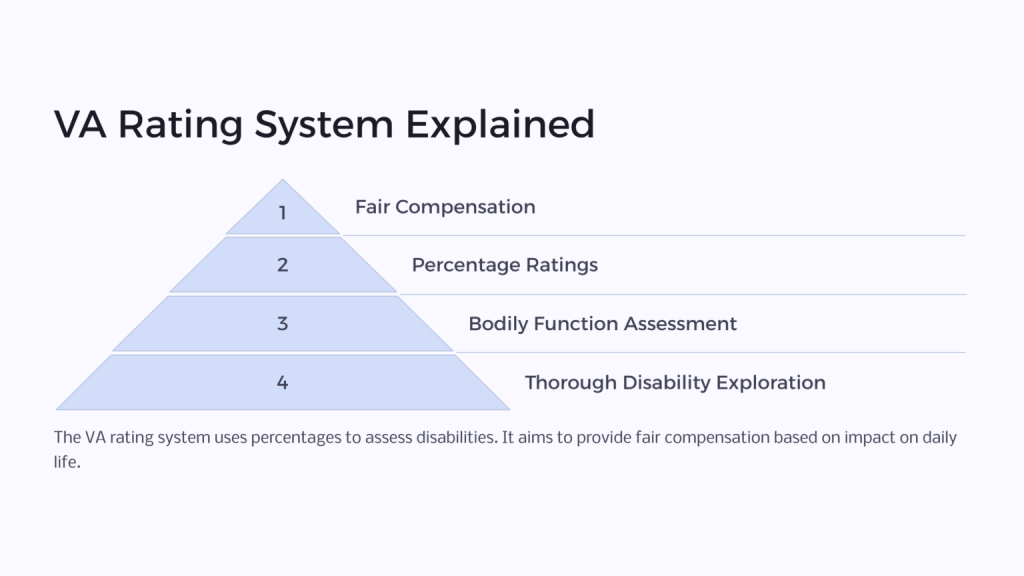
“Living with a disability in one leg or arm is hard enough – daily tasks like walking up stairs and buttoning a shirt aren’t so simple anymore. But when disabilities affect both sides of your body, your ability to do these simple tasks or support yourself may become even more limited.
The VA understands that veterans in this situation face added obstacles, and that’s where the VA bilateral factor comes in. If you’re dealing with a disability on both the right and left sides of your body or in paired skeletal muscles, you may qualify.” [1]
What is the Bilateral Factor for VA Disability?
“The VA disability bilateral factor was implemented to assist veterans with a disability affecting both arms, both legs, or paired skeletal muscles.
Eligible veterans receive a 10% addition to their service-connected VA rating before continuing with further combinations or converting to the degree of disability.
The VA acknowledges that veterans with two disabled limbs have a significant impact on daily life.
The bilateral factor applies if you have disabilities affecting your left and right lower extremities or the left and right upper extremities.
However, they don’t have to be the same body parts. For example, you would still qualify if you had left knee and right ankle conditions because there are two conditions on two separate body parts in the lower extremities.
In addition, the VA bilateral factor isn’t applicable unless there is a partial disability of a compensable degree in each of the two paired extremities or paired skeletal muscles.
If the combined evaluation is lower than what would be achieved by not including one or more bilateral disabilities in the calculation, those bilateral disabilities would be removed and combined separately, ensuring you receive the most favorable combined evaluation.
Note: You don’t have to have the same disability on both sides of your body for the VA bilateral factor to apply.” [2]

“Am I Eligible for the VA Bilateral Factor?
To qualify for the bilateral factor in your VA disability claim, certain criteria must be met:
Bilateral Disabilities: You must have disabilities on both sides of your body. This can include conditions affecting both arms, both legs, or any other paired organs or areas.
Paired Disabilities: The conditions do not have to be the same on both sides but must affect paired body parts.
Service Connection: The disabilities must be service-connected, directly related to or aggravated by your military service.” [3]
“How Does the VA Rating System Work?
The VA determines the severity of your disabilities based on the evidence you submit as part of your claim for VA disability benefits or information the VA obtains through your military records. VA rates each disability from zero to 100 percent in 10 percent increments. If the VA finds that you have multiple disabilities, it will use the Combined Ratings Table to calculate a combined disability rating.
Theoretically, a combined rating represents how much the combined disabilities affect a Veteran’s ability to work—in other words, approximately how much less efficiently the Veteran can work due to the combination of their individual disabilities.” [4]

“How Does the VA Combine Individual Ratings?
One commonly misunderstood area of VA disability involves how the VA combines individual ratings, especially concerning the bilateral factor. When a Veteran has two or more service-connected disabilities, each unique disability gets its own individual rating or percentage of disability.
You might think the VA would simply add those ratings to get the combined rating, but they do not. Instead, the VA employs a calculation, colloquially known as “VA math,” to combine them ratings using a descending efficiency scale. Here’s how it works.” [4]
“VA Combined Disability Rating: The Math
The combined rating begins by assuming a Veteran has a 100 percent efficiency rate. The VA multiplies the efficiency rate by the disability rating and subtracts the result of that calculation from the efficiency rate.
So, if a Veteran’s highest-rated disability were 50 percent, the first calculation would look like this:
Efficiency rate of 100 x 50 percent = 50. Then 100 – 50 = 50.
If the second-highest disability were 40 percent, the second calculation would look like this:
50 x 40 percent = 20, then 50 – 20 = 30.
In this case, 30 becomes the new efficiency rate, and the Veteran is considered 70 percent disabled.” [4]
The bilateral factor is a nuance that many veterans miss. If their doctors don’t know of its significance, bilateral conditions can be left out of medical records, penalizing veterans who are applying for disability benefits. This is another reason why it’s important to show your VA Award Letter to a veterans’ rights attorney if you have any trouble understanding your disability claim.
Contact a specific layer to help with this process.
Resources
[1] https://www.woodslawyers.com/how-the-va-disability-bilateral-factor-affects-veterans-ratings/
[2] https://vaclaimsinsider.com/va-bilateral-factor/
[3] https://www.hillandponton.com/bilateral-factor-va-disability-rating/
[4] https://ptsdlawyers.com/the-bilateral-factor-for-va-disability-compensation/
